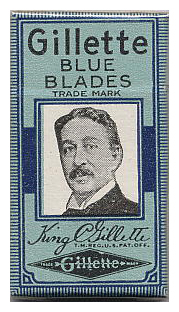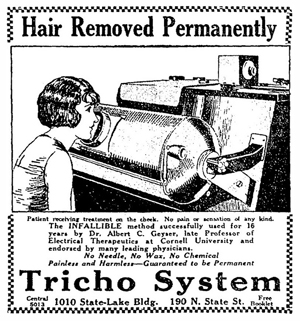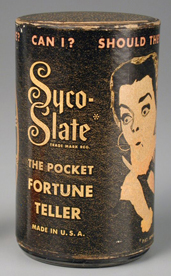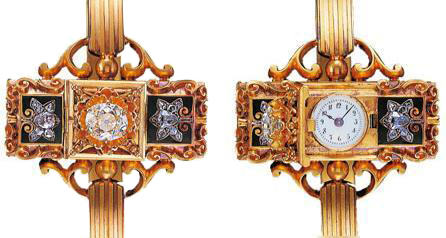 King C. Gillette was inspired to invent the disposable razor by his job as a salesman. He was working for the Crown Cork and Seal Company in the 1890’s selling bottle caps. The inventor of the bottle cap, William Painter, advised Gillette to “invent something people would use and throw away.” Gillette recognized the brilliance of this statement when he saw how successful the Crown Cork and Seal Company had become.
King C. Gillette was inspired to invent the disposable razor by his job as a salesman. He was working for the Crown Cork and Seal Company in the 1890’s selling bottle caps. The inventor of the bottle cap, William Painter, advised Gillette to “invent something people would use and throw away.” Gillette recognized the brilliance of this statement when he saw how successful the Crown Cork and Seal Company had become.
Over the years, Gillette thought of and rejected many possible ideas for disposable products. Then one day, in 1895, he had the idea of producing a safe and disposable razor. When traveling, Gillette would often shave in the bathroom of a train using a safety-razor, which was a heavy blade fit into a wooden handle. This was much safer then using a straight razor but the safety-razor had to be sharpened often and wore out too quickly.
Instead, Gillette wanted to design an inexpensive blade using a piece of steel. The blade could then be replaced easily when it grew dull. For the next six years, Gillette attempted to have such a blade produced. He was told by many experts, including metallurgists at MIT, that it would be impossible to manufacture steel that would be thin, hard and cheap enough. Continue reading “Invent Something People Would Use and Throw Away”


 On November 8, 1895, German physicist Wilhelm Röntgen discovered x-ray. The invention was a major scientific breakthrough and the world became fascinated with x-rays. Amazingly, people could now see their bones. X-rays were quickly embraced by physicians and scientists around the world. Physicians began using the machines in their offices. A shoe fitting device using x-rays was patented. There was even a system designed using x-rays to remove excessive hair.
On November 8, 1895, German physicist Wilhelm Röntgen discovered x-ray. The invention was a major scientific breakthrough and the world became fascinated with x-rays. Amazingly, people could now see their bones. X-rays were quickly embraced by physicians and scientists around the world. Physicians began using the machines in their offices. A shoe fitting device using x-rays was patented. There was even a system designed using x-rays to remove excessive hair. John Gatling was not a man out to promote war and the killing of men with his invention. Instead, Gatling believed that the invention of an automatic weapon would reduce war and the death of soldiers. He thought because the gun would have such a devastating effect on the armies, once seen on the battlefield it would send the other side running. In addition, a weapon that had the impact of many men when used by few would reduce the number of soldiers needed thereby reducing the number of casualties.
John Gatling was not a man out to promote war and the killing of men with his invention. Instead, Gatling believed that the invention of an automatic weapon would reduce war and the death of soldiers. He thought because the gun would have such a devastating effect on the armies, once seen on the battlefield it would send the other side running. In addition, a weapon that had the impact of many men when used by few would reduce the number of soldiers needed thereby reducing the number of casualties. The Magic 8-Ball was inspired by fake seances. Mary Carter, a phony fortune teller, created a spirit writing device. Using a slate enclosed in a box, Carter could secretly write and pretend the spirits were communicating with the device. Her son, Alfred Carter, was amazed by the invention but wanted to make a device that required no skill to use.
The Magic 8-Ball was inspired by fake seances. Mary Carter, a phony fortune teller, created a spirit writing device. Using a slate enclosed in a box, Carter could secretly write and pretend the spirits were communicating with the device. Her son, Alfred Carter, was amazed by the invention but wanted to make a device that required no skill to use. Wristwatches were originally designed for women to be worn as a type of jewelry. The first wristwatch was manufactured by the Swiss watch company, Patek Philippe in 1868. The watch was sold to Countess Koscowicz of Hungary in 1876. The first wristwatch was more ornamental than a time keeping device. It was very ornate, clunky and shaped like a triptych. The time piece was framed by two diamond-and-gold panels and was wound with a key.
Wristwatches were originally designed for women to be worn as a type of jewelry. The first wristwatch was manufactured by the Swiss watch company, Patek Philippe in 1868. The watch was sold to Countess Koscowicz of Hungary in 1876. The first wristwatch was more ornamental than a time keeping device. It was very ornate, clunky and shaped like a triptych. The time piece was framed by two diamond-and-gold panels and was wound with a key. Raymond E. DeWalt followed in the family tradition working in mills and construction. The jobs were difficult and labor intensive. DeWalt was always looking for ways to cut costs, make jobs easier and be more efficient. His solutions often included creating machines to help with the work.
Raymond E. DeWalt followed in the family tradition working in mills and construction. The jobs were difficult and labor intensive. DeWalt was always looking for ways to cut costs, make jobs easier and be more efficient. His solutions often included creating machines to help with the work.